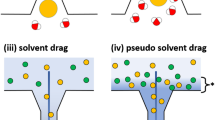Summary
Urea added to the outside of toad skin bathed in Ringer's solution increases the permeability of the skin to urea and sucrose, and creates a net inward flow of sucrose with a flux ratio of 3 to 4. Two hypotheses aim at explaining the sucrose transport, the first as entrainment in an inwardly directed water flow (anomalous solvent drag) created by urea (driving species) diffusion in the lateral intercellular spaces, the second as a direct solute-solute interaction.
The anomalous solvent drag model was formulated mathematically and simulated on an analogue computer. This permitted quantitative examination of the model assumptions and predictions. The flux ratio for the driven species (sucrose) was a function of two dimensionless parameters including the geometrical restrictions on the intercellular spaces, concentration of driving species, and diffusion coefficient of driving and driven species. For a range of experimental values of the system parameters, the calculated flux ratios of driven species were in agreement with most experimental findings. The unilateral fluxes would have to be restricted to 10−3 to 10−4 of the simple skin area. The ratio between the sucrose and urea flux ratios predicted by the model was equal to the observed value.
The solute-solute interaction model requires a coupling coefficient of 10−3 to account for the observed flux ratio. It is concluded that the anomalous solvent drag model is compatible with the bulk of experimental evidence available, whereas solute-solute interaction as occurring in free diffusion is far from being quantitatively sufficient.
Similar content being viewed by others
References
Biber, T. U. L., Curran, P. F. 1968. Coupled solute fluxes in toad skin.J. Gen. Physiol. 51:606.
Bridgmann, P. W. 1922. Dimensional Analysis. Yale University Press New Haven, Conn.
Curran, P. F. 1960. Na, Cl and water transport by rat ileumin vitro.J. Gen. Physiol. 43:1137.
Diamond, J. M., Bossert, W. H. 1967. Standing-gradient osmotic flow.J. Gen. Physiol. 50:2061.
Dunlop, P. J. 1957. A study of interacting flows in diffusion of the system raffinose-KCl−H2O at 25°.J. Phys. Chem. 61:994.
Ellerton, H. D., Dunlop, P. J. 1967a. Diffusion and frictional coefficients for four compositions of the system water-sucrose-mannitol at 25°. Tests of the Onsager reciprocal relation.J. Phys. Chem. 71:1291.
Ellerton, H. D., Dunlop, P. J. 1967b. Ternary diffusion and frictional coefficients for one composition of the system water-urea-sucrose at 25°. A test of the Onsager reciprocal relation for this system.J. Phys. Chem. 71:1538.
Erlij, D., Martinez-Palomo, A. 1972. Opening of tight junctions in frog skin by hypertonic urea solutions.J. Membrane Biol. 9:229.
Farquhar, M. G., Palade, G. E. 1965. Cell junctions in the amphibian skin.J. Cell. Biol. 26:263.
Franz, T. J., Bruggen, J. T. van 1967. Hyperosmolarity and the net transport of non-electrolytes in frog skin.J. Gen. Physiol. 50:933.
Franz, T. J., Galey, W. R., Bruggen, J. T. van 1968. Further observation on asymmetrical solute movement across membranes.J. Gen. Physiol. 51:1.
Fujita, H., Gosting, L. G. 1960. A new procedure for calculating the four diffusion coefficients of three-component systems from Gouy diffusiometer data.J. Phys. Chem. 64:1256.
Galey, W. R., Bruggen, J. T. van 1970. The coupling of solute fluxes in membranes.J. Gen. Physiol. 55:220.
Koefoed-Johnsen, V., Ussing, H. H. 1953. The contribution of diffusion and flow to the passage of D2O through living membranes.Acta. Physiol. Scand. 28:60.
Lindemann, B., Pring, M. 1969. A model of water absorbing epithelial cells with variable cellular volume and variable width of the lateral intercellular gaps.Pflüg. Arch. Ges. Physiol. 307:55.
MacRobbie, E. A. C., Ussing, H. H. 1961. Osmotic behaviour of the epithelial cells of frog skin.Acta Physiol. Scand. 53:348.
Martinez-Palomo, A., Erlij, D., Bracho, H. 1971. Localization of permeability barriers in the frog skin epithelium.J. Cell. Biol. 50:277.
Patlak, C. S., Rapoport, I. 1971. Theoretical analysis of net tracer flux due to volume circulation in a membrane with pores of different sizes.J. Gen. Physiol. 57:113.
Schmidt-Nielsen, B., Truniger, B., Rabinowitz, L. 1972. Sodium linked urea transport by the renal tubule of the spiny dogfishSqualus acanthias.Comp. Biochem. Physiol. 42A:13.
Segel, L. A. 1970. Standing-gradient flows driven by active solute transport.J. Theoret. Biol. 29:233.
Urakabe, S., Handler, J. S., Orloff, J. 1970. Effect of hypertonicity on permeability properties of the toad bladder.Amer. J. Physiol. 218:1179.
Ussing, H. H. 1966. Anomalous transport of electrolytes and sucrose through the isolated frog skin induced by hypertonicity of the outside bathing solution.Ann. N. Y. Acad. Sci. 137:543.
Ussing, H. H. 1969. The interpretation of tracer fluxes in terms of membrane structure.Quart. Rev. Biophys. 1:365.
Ussing, H. H., Johansen, B. 1969. Anomalous transport of sucrose and urea in toad skin.Nephron 6:317.
Whittembury, G. 1962. Action of antidiuretic hormone on the equivalent pore radius at both surfaces of the epithelium of the isolated toad skin.J. Gen. Physiol. 46:117.
Author information
Authors and Affiliations
Rights and permissions
About this article
Cite this article
Stender, S., Kristensen, K. & Skadhauge, E. Solvent drag by solute-linked water flow. J. Membrain Biol. 11, 377–398 (1973). https://doi.org/10.1007/BF01869831
Received:
Issue Date:
DOI: https://doi.org/10.1007/BF01869831




